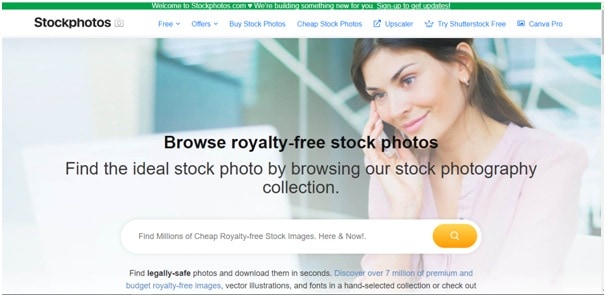
How to Boost Your Website Conversions with Images

The online landscape is full of competition. Today, every website owner struggles to increase conversions, but not many succeed.
If you are in the same boat, you can learn to enhance the visual experience for your website visitors. You might have a fantastic web design with a complementing theme and amazing colours. But that is not enough.
When people are willing to spend money on something, they need reliability and assurance. You can earn both of these through using high-quality, relevant images.
Yes, even in the digital world, people prefer to see before committing to any product or service. And providing them with the relevant images can help them make better purchase decisions. In return, the practice will improve your site’s conversions. Read on to learn more about the lucrative strategies you can use with image implementation.
1. Increase Transparency by Displaying Images of Real People
Gone are the days when prospects were only concerned about the product. Today, people look for brands whom they trust. That is why every other brand is working to enhance consumer relations.
One ideal way to build trust is by showing pictures of your staff, work in progress, and the internal environment. When people see how many people work together to create a single product, you will gain their trust.
Now, think of a scenario in which you visit two websites for the same product. One of them shows the production cycle, staff, and the hard work behind the product. While the other is only displaying the product’s images, description, and price.
Undoubtedly, you will go for the former one.
See how Coca-Cola shares the pictures of its team members along with their designations on the website. This practice humanizes the famous beverage company and allows the buyers to connect with the team.

2. Tell People about Training and Development Programs
Brands that pay attention to the training and development of employees are considered ideal in terms of quality. People feel that the business is continuously working hard to hone the skills of its employees. Consequently, they get a premium product in the end.
Images of these training sessions will be proof of what you say. Share pictures of the trainer and capture the number of employees. You can also share images of events, annual dinners, and picnic parties held for employee collaboration and morale-building.
3. Use the Right Size and Placement for Every Image
Images can boost conversions; that’s true! But, never clutter your web page with too many pictures. Keeping a balance is also essential for giving a great visual experience.
If you are using a large hero image in the background, a single image is enough. Check out the homepage of Stock photos. You can see how they showcase the background image so it doesn’t interfere with the overall visual display.

And, do you know about the Z and F pattern?
Experts believe that people look at your website either in the Z or the F pattern. In both cases, one thing is clear: they start from left to right. Besides this, they don’t read content like a book. Thus, all essential elements should be placed in any of these patterns.
An ideal way to arrange the pictures is to place your logo in the upper left corner and the rest of the images at suitable points in these patterns. In this way, you can make the images more noticeable, boosting engagement.
Furthermore, using the right size for the header, logo, and background images is important too. As a general rule of thumb, the ideal size for images is:
- Header: 1048 × 250 pixels
- Background:1920 × 1080 pixels
- Blog post:1200 × 630 pixels
4. Trigger Emotions Through Images
Since consumers develop some connection with the brand before purchasing, it’s essential to trigger their emotions. People should know how the product will make them feel. And nothing can do this job better than images.
Look at the below example of Away Resorts. The company claims that they have something for everyone, and the picture supports its statement. A couple looks happy, and so do the kids.

5. Show How Your Business Gives Back to the Community
One ideal way to develop a positive brand image is to display how you and your organization work for charity and community activities.
For example, today, people are more aware of sustainability. They love supporting brands that consider eco-friendliness. Therefore, if your business is recycling or adopting measures to reduce waste, don’t forget to share the shots. After purchasing goods from such brands, people get a sense of satisfaction. They feel like being a part of something better for their community and the environment.
6. Use High Quality Images
Using real and custom photos on your website is the best option for boosting engagement with visitors. But, not every business can manage to get these images. They require plenty of time and can be expensive. It is where stock photos can help us.
However, if you are going to choose stock images, you need to ensure their quality. Though they are readily available, the free ones are likely overused and may appear cliche. Your website visitors may get a negative impact after seeing these common photos on your site.
Paying for high-quality unique stock images is a better option. Besides this, customizing these pictures is also possible. Today, tools like Pixlr, BeFunky, PhotoDirector Essential, and others are present. You can easily edit these images to further enhance their quality.
7. Always Pay Attention to Image SEO
Using high-quality and impressive photos will be useless if you are not working on image SEO. The online market is competitive, and every website owner is working hard to get maximum traffic.
Today, image SEO is as crucial as website optimization. It covers various elements to enhance your page’s visibility.
Firstly, you need to pick a suitable image size that doesn’t affect your site’s loading time. Then, you need to write its title. When you write the image title, make sure to keep it short.
You also need to write the alt text. It is the text that people will see if the site takes too long to load. Try to keep it specific and use one focus keyword in it. Understand the main difference between the two. The title is generic and short, whereas alt text is specific, has a keyword, and covers four to five words.
Example:
Title: Cupcake
Alt-text: lemon butter cupcake with cheese frosting
Moreover, don’t forget to submit an image sitemap to Google. The map helps the search engine understand your site’s images. It contains the URL and a short description of each image.
Wrapping It Up
Overall, boosting website conversions is the biggest dream of every online business owner. Thankfully, images can help us achieve this goal. Using images of real people, displaying emotions, and showing high-quality pictures can significantly increase your conversions.
Besides this, the correct placement, image SEO, and display of business culture are also mandatory. If you follow the tips mentioned above, you will successfully reach your conversion targets.
